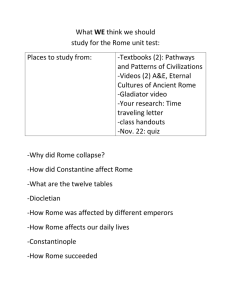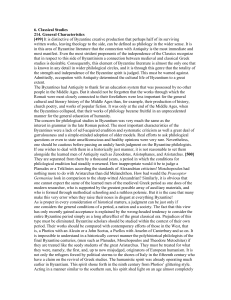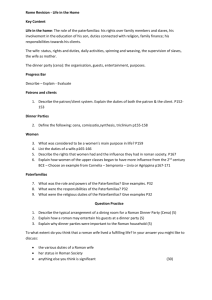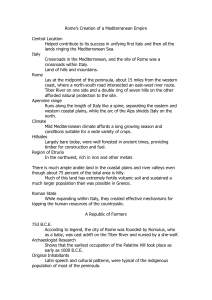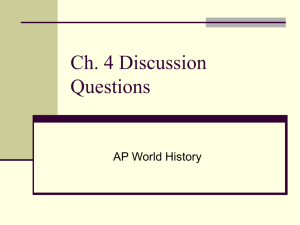Roman Civilization PERSIAN Chart - AP World History
advertisement
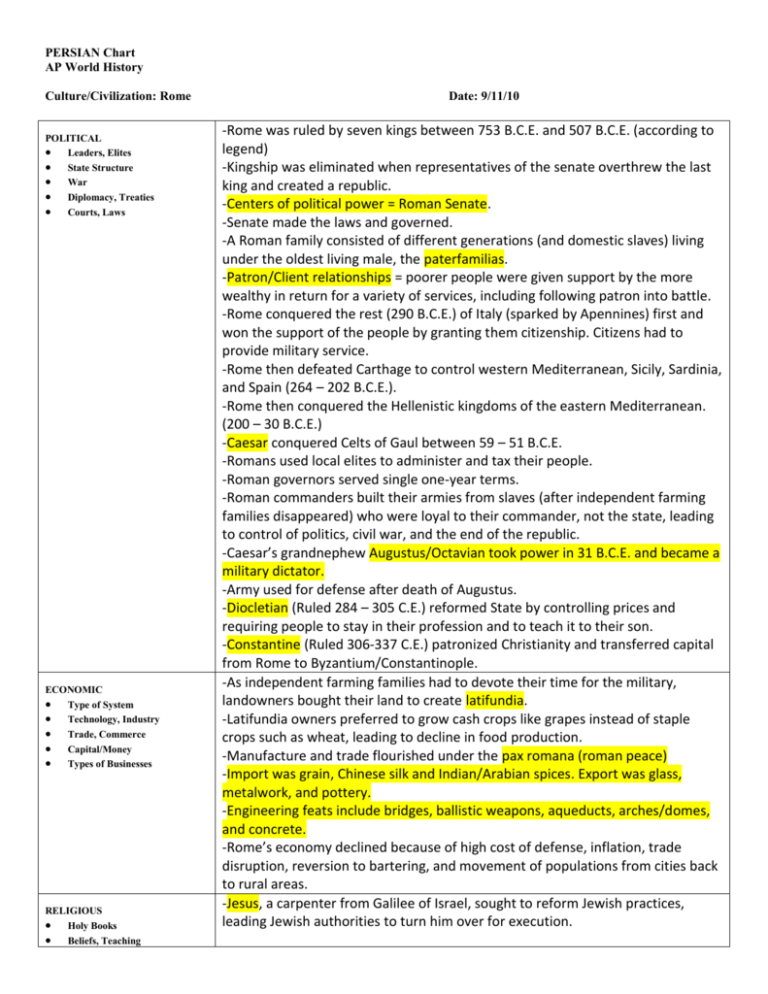
PERSIAN Chart AP World History Culture/Civilization: Rome POLITICAL Leaders, Elites State Structure War Diplomacy, Treaties Courts, Laws ECONOMIC Type of System Technology, Industry Trade, Commerce Capital/Money Types of Businesses RELIGIOUS Holy Books Beliefs, Teaching Date: 9/11/10 -Rome was ruled by seven kings between 753 B.C.E. and 507 B.C.E. (according to legend) -Kingship was eliminated when representatives of the senate overthrew the last king and created a republic. -Centers of political power = Roman Senate. -Senate made the laws and governed. -A Roman family consisted of different generations (and domestic slaves) living under the oldest living male, the paterfamilias. -Patron/Client relationships = poorer people were given support by the more wealthy in return for a variety of services, including following patron into battle. -Rome conquered the rest (290 B.C.E.) of Italy (sparked by Apennines) first and won the support of the people by granting them citizenship. Citizens had to provide military service. -Rome then defeated Carthage to control western Mediterranean, Sicily, Sardinia, and Spain (264 – 202 B.C.E.). -Rome then conquered the Hellenistic kingdoms of the eastern Mediterranean. (200 – 30 B.C.E.) -Caesar conquered Celts of Gaul between 59 – 51 B.C.E. -Romans used local elites to administer and tax their people. -Roman governors served single one-year terms. -Roman commanders built their armies from slaves (after independent farming families disappeared) who were loyal to their commander, not the state, leading to control of politics, civil war, and the end of the republic. -Caesar’s grandnephew Augustus/Octavian took power in 31 B.C.E. and became a military dictator. -Army used for defense after death of Augustus. -Diocletian (Ruled 284 – 305 C.E.) reformed State by controlling prices and requiring people to stay in their profession and to teach it to their son. -Constantine (Ruled 306-337 C.E.) patronized Christianity and transferred capital from Rome to Byzantium/Constantinople. -As independent farming families had to devote their time for the military, landowners bought their land to create latifundia. -Latifundia owners preferred to grow cash crops like grapes instead of staple crops such as wheat, leading to decline in food production. -Manufacture and trade flourished under the pax romana (roman peace) -Import was grain, Chinese silk and Indian/Arabian spices. Export was glass, metalwork, and pottery. -Engineering feats include bridges, ballistic weapons, aqueducts, arches/domes, and concrete. -Rome’s economy declined because of high cost of defense, inflation, trade disruption, reversion to bartering, and movement of populations from cities back to rural areas. -Jesus, a carpenter from Galilee of Israel, sought to reform Jewish practices, leading Jewish authorities to turn him over for execution. Conversion Sin/Salvation Deities SOCIAL Family Gender Relations Social Classes Inequalities Life Styles INTELLECTUAL Art, Music Writing, Literature Philosophy Math & Science Education -His disciples spread his teachings after death, also saying that he had been resurrected. Their targets were their fellow Jews. -Paul discovered that non-Jews (or gentiles) were more receptive than Jews to the teachings of Jesus. (40-70 C.E.) -Christianity grew for two centuries, developing a hierarchy and becoming a good sized minority. -Christianity grew when Romans became dissatisfied with their traditional religion. -Roman family was under the authority of the paterfamilias (oldest living male). -Roman women had more freedom than Greek women. -Roman women w/ children were still subordinate to the paterfamilias. -Later women could take part in a marriage that allowed them to become independent after the death of their fathers. -Slaves were Italians who were driven off their land, not employed by latifundia owners, and had drifted into cities. -Patron/client relationships institutionalized inequality and became a system of mutual benefits/obligations. -Rome was an urban empire, even though 80% of its population were rural farmers. -Upper classes lived lavish lifestyle w/ houses centered around atriums. The poor lived conversely. -Rural life involved hard work and little entertainment. -Rural land was owned by landlords in the city and watched over by hired foremen. -Romanization occurred in western empire when Latin language and Roman way of life was adopted by locals. -Poets expressed their love for women who were educated and outspoken. ARTS Art, Music Writing, Literature NEAR: GEOGRAPHY Location Physical Movement Human/Environment Region NOTES: -Italy and Sicily = crossroads of Mediterranean and links Africa and Europe. -Rome was the midpoint of the crossroads. -Italy’s natural resources were rivers for transportation/water, forests for wood, iron, a mild climate, and a large enough area of arable land to support large populations. -Rome inhabited around 1000 B.C.E. -Rome expanded slowly at first, but then rapidly in the third and second centuries B.C.E. until it became one huge Mediterranean empire.

